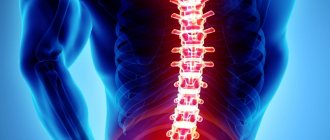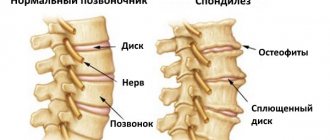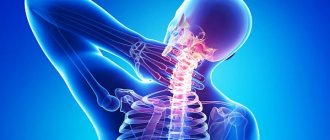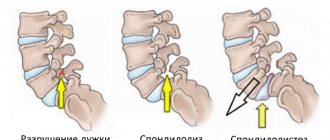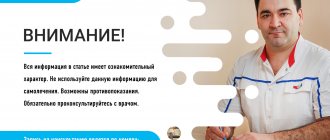Make an appointment by phone: +7 (343) 355-56-57
+7
- About the disease
- How to cure
- Prices
- Sign up
- Specialists
- About the disease
- Prices
- Sign up
Spinal diseases affect 70% of the world's population. Pain reduces social activity and leads to temporary disability. The process can occur in different parts of the spine. Often the cause of ailments is destruction of the lower back, which characterizes lumbosacral radiculitis.
Causes
- degenerative changes: osteochondrosis (protrusion, disc herniation), spondyloarthrosis, vertebral displacement (spondylolisthesis, spondylolysis)
- vertebral compression fractures due to osteoporosis or trauma
- problems with posture (scoliosis, kyphosis, lordosis);
- inflammatory process (spondylodiscitis, spondyloarthritis, rheumatoid arthritis, abscess)
- tumors;
The process can be triggered by: physical activity, hypothermia, lifting (carrying) heavy objects, a sedentary lifestyle and excess weight, pregnancy.
How to treat radiculitis: technique
After a detailed diagnosis, the doctor prescribes therapy and determines how to treat radiculitis. In most cases, conservative methods are used. The treatment regimen includes:
- immobilization of the spine (the patient is prescribed strict bed rest until acute pain disappears);
- oral administration or intramuscular injections of analgesics;
- use of local irritants (for example, pepper patch);
- taking anti-inflammatory drugs;
- physical therapy;
- manual therapy courses;
- blockade of muscles in a state of spasm;
- vitamin B12 injections;
- acupuncture;
- traction of the spine, which allows you to increase the gaps between the vertebrae and release pinched nerve endings;
- radon and hydrogen sulfide baths;
- mud therapy.
Diet therapy plays a special role in the question of how to treat radiculitis. The patient is recommended to eat small portions up to 5 times a day. It is recommended to exclude the following foods from the diet:
- flour products;
- strong broths;
- sweets;
- fat meat;
- smoked meats;
- coffee and other drinks with high caffeine content;
- salty snacks;
- hot spices;
- alcohol;
- carbonated drinks.
The patient's menu should include a lot of vegetables and fruits, foods rich in fiber, lean fish, cereals and legumes. Cucumbers, radishes, tomatoes, persimmons, dried apricots, pomegranates, carrots, black elderberries, prunes and cabbage are especially useful for radiculitis.
It is not always advisable to treat radiculitis as prescribed by the conservative therapy regimen. If after 3-4 months of treatment the patient cannot completely get rid of the pain, then he is offered to undergo surgery (remove the herniated disc). The indisputable reason for surgical intervention is paralyzing sciatica (damage to the sciatic nerve roots).
Come to our clinic.
With timely diagnosis and adequate treatment, the prognosis for radiculitis is favorable. We will help you achieve long-term remission or complete recovery! radiculitis
Symptoms
The main place among the symptoms of lumbosacral radiculitis is pain. Classification by type of pain syndrome:
- 1. Lumbago. This is a reflex spasm of the paravertebral muscles. Characterized by acute pain in the lower back. Often occurs during (after) physical activity.
- 2. Lumboischialgia. This is a reflex spasm of the paravertebral muscles and piriformis muscle (usually on one side) irradiating to the gluteal region.
- 3. Lumbar radiculopathy: pain in the lumbar region with irradiation along the affected radicular nerve, sensory and motor disturbances in the area of nerve intervention. The upper segments 1-3 are the perineum, genitals, 4-5 and 1 cross are the lower limbs. In the chronic course of the disease, sensory and motor impairments may no longer recover, a chronic pain syndrome may form, the most dangerous complication is spinal canal stenosis with pressure on the spinal cord or spinal cord roots (cauda equina). Paresis of the lower extremities and pelvic dysfunction develop. This complication requires an emergency consultation with a neurosurgeon and a solution to the issue of surgical intervention and decompression of the spinal canal.
Radiculitis lumbosacral
11044 June 29
IMPORTANT!
The information in this section cannot be used for self-diagnosis and self-treatment.
In case of pain or other exacerbation of the disease, diagnostic tests should be prescribed only by the attending physician. To make a diagnosis and properly prescribe treatment, you should contact your doctor. Lumbosacral radiculitis: causes of occurrence, what diseases it occurs with, diagnosis and treatment methods.
Definition
Lumbosacral radiculitis, or radiculopathy, is a symptom complex that occurs as a result of pinching and inflammation of the spinal nerve roots in the lumbar and/or sacral spine.
Typically, this condition develops in people over 45, but in recent years, young people have also begun to complain of sciatica.
People whose work involves heavy physical labor or prolonged stay in one position, professional athletes are susceptible to the development of radiculopathy; patients with autoimmune diseases; those who are overweight and/or have metabolic diseases.
Radiculitis is characterized by lower back pain combined with shooting or pulling pain along the side or back of the leg (sometimes down to the foot), numbness and paresthesia, muscle weakness, increased pain when raising a straight leg.
Varieties of radiculitis
Radiculopathy can result from mechanical damage or an infectious process. Damage can develop both in the intervertebral discs and directly in the vertebral body or its processes.
Pain with radiculitis can be sharp (lumbago), shooting or stabbing (sciatica), burning or aching (lumboischialgia).
- Lumbago is an acute pain that appears suddenly as a result of sudden lifting of weights, sneezing, coughing, due to hypothermia of the lower back (for example, under air conditioning) or spasms of the lower back muscles, or intervertebral hernias.
- Sciatica is a shooting or stabbing pain that radiates to the buttocks, thighs, and calf muscles, as a result of which the patient may complain of muscle weakness (“legs can’t hold up”) and even numbness of the limbs.
- Lumboischialgia is a burning or aching pain that is localized in the gluteal muscles and thighs. It is characterized by a gradual increase.
Possible causes of sciatica
- Hernia or protrusion (bulging) of the intervertebral disc.
- Spondylosis is a chronic degenerative lesion of the spine that develops as a result of aging, overload or injury.
- Spinal stenosis.
- Osteophytes are growths of bone tissue that resemble hooks or spines in shape.
- Sacralization or lumbarization of the sacrum.
- Spondyloarthrosis is a chronic disease of the intervertebral joints, manifested by degenerative changes in cartilaginous tissues and leading to a decrease in the height of the intervertebral discs, tightening of the ligaments, and deformation of the intervertebral joints.
- Ankylosing spondylitis (Bechterew's disease).
- Vertebral fractures (including compression fractures due to osteoporosis).
- Hormonal changes that reduce the strength of cartilage and bone tissue.
Which doctors should you contact if you have lower back pain
? If you have signs of radiculitis, you should consult a doctor for examination and clarification of the diagnosis. In the future, he is engaged in the treatment of radiculitis.
Diagnostics and examinations for radiculitis
Before prescribing instrumental examinations, the doctor collects anamnesis and conducts physiological tests to identify symptoms of “tension” - specific signs of pathology of the nerve roots.
To diagnose spinal diseases the following is prescribed:
- X-ray of the lumbosacral spine with functional tests;
Treatment of radiculitis with folk remedies
Did you know that...
Next fact
Many people practice treating radiculitis at home, widely using the range of knowledge of traditional medicine. The advantage of these methods is that they are very accessible and take little time .
It is worth remembering that traditional treatment is not the main method of treating radiculitis. In addition, they can be used not only for treatment, but also for the prevention of the disease. Decoctions, tinctures, self-prepared ointments, healing baths perfectly tone and warm up muscles, help relax and reduce stress on the nervous system and musculoskeletal system.
Another important fact is that you can carry out therapeutic measures without leaving your home. Attacks of radiculitis are extremely painful; even moving around the house causes enormous discomfort, not to mention going to the clinic and spending time in line.
But it is worth noting that folk remedies are not a panacea for this disease . Consultation with a specialist and his approval to carry out preventive or alleviating procedures is simply necessary for any deviation from the norm, and especially for radiculitis. It is the specialist who must assess your health status, concomitant diseases, age, and tell you about the possible dosage.
Self-medication often aggravates existing chronic diseases. For example, the use of some components of tinctures increases blood pressure (contraindicated for hypertensive patients), increases stomach acidity (cannot be used for gastritis), etc. .
Traditional medicine recipes for radiculitis
Radiculitis occurs suddenly and occurs in a rather acute form, so you need to act immediately. These recipes from the treasury of wisdom of our people will help you significantly improve your condition at the time of exacerbation of the disease.
Potato compresses
Boil 5 small potato tubers (along with skins), chop with a fork or using a blender. Apply the resulting puree to a clean cloth and apply to the sore spot. Wrap the top with a warm cloth and ensure complete static conditions. Repeat 3 times during the day.
Healer bulb
Peel a medium onion and cut in half. Massage your back or neck with circular movements for 15-20 minutes. Repeat the procedure every 2 hours.
Warm cabbage leaves
Separate five medium leaves from a head of cabbage. Place them in boiling water for 6 minutes. Next, take it out, cool slightly and apply to the sore spot. Wrap the top with a terry towel: change the leaves as it cools. One session – 30 minutes. A minimum of three sessions must be done per day. On the third day there is usually relief.
Hop compress
Boil hop leaves and stems in a small saucepan, then remove from it with a slotted spoon and wrap in cheesecloth. Apply the compress to your back (neck) and cover with a woolen product. In this case, a healing belt will come in handy. The higher the temperature of the poultice, the more effective. However, the leaves should not be applied too hot to avoid burns.
Pay attention to recipes for preparing remedies for back painVinegar and rosemary
In the ancient books of Russian healers you can find a very unusual, but at the same time useful recipe for eliminating pain from radiculitis. To do this, take a bunch of rosemary (10-15 medium sprigs) and immerse it in boiling water for 10 minutes. Place a cotton cloth over the steam generated in the pan.
As soon as the canvas has become wet, it is moistened with 9% vinegar diluted with water (diluted 1/1) and applied to the site of inflammation.
After holding the compress for 10-15 minutes, you need to forcefully rub your back or neck until the skin becomes slightly red. The procedure is carried out once a day for 4 days.
As noted above, radiculitis is treated not only by external influences. In folk medicine, there are many recipes for tinctures that are taken orally.
Radish wine
To prepare a healing drink, you need one small fresh radish root vegetable. Chop the vegetable into cubes and mix with 450 g of white wine. Leave in a dark, cool place for a month. After a month, strain the drink and take one tablespoon twice a day after meals. The course of treatment is 7 days.
Tea for pain relief
Heat the water to approximately 90 degrees. Reduce heat to low and add a pinch of anise seeds, marjoram leaves, mint and a sprig of rosemary. Boil for 5 minutes. Cool to room temperature and take 200 ml twice a day.
Willow decoction
Willow contains a large amount of salicin, which has a beneficial effect on the nervous system and facilitates recovery processes. A huge amount of this beneficial substance is contained in the bark of the willow tree. Therefore, it would be more advisable to use not leaves, but rather willow bark or twigs in preparing the decoction. For one liter you will need a small piece (about the size of your palm) of bark or 3-4 small twigs. Boil them in clean water (15 minutes) and take one glass every day.
Collection of herbs
All these herbs can be found in dried form at the pharmacy. The proportions can be changed depending on the amount of water. We will make one liter of healing decoction. To do this you will need 2 tablespoons of thyme, a bunch of nettles and oregano. Boil for 5 minutes and let sit for about one hour. Take both during exacerbation and for prevention: for pain – 2 glasses per day; for tone – 1 glass.
Massaging the sore spot is a great help in the fight against radiculitis. This process is quite painful, so healing oil can be used to enhance the effect.
Massage oil
For 1 liter of olive oil you need to take 200 g of calendula flowers (popularly “marigold”), 150 g of plantain leaves and stems, and 200 g of St. John’s wort. The oil needs to be slightly heated in a water bath, add all the ingredients and warm it well (temperature about 80 degrees). Cool the resulting mass and leave in a dark place for 3 days. The resulting oil can be stored for only one month.
Video: “Treatment of radiculitis according to hunting: an old recipe”
